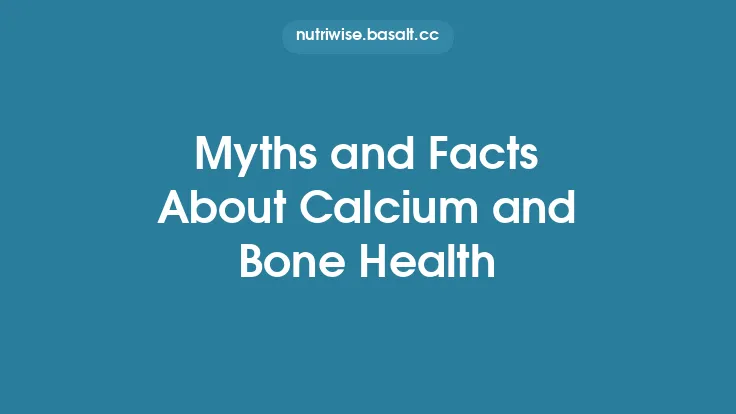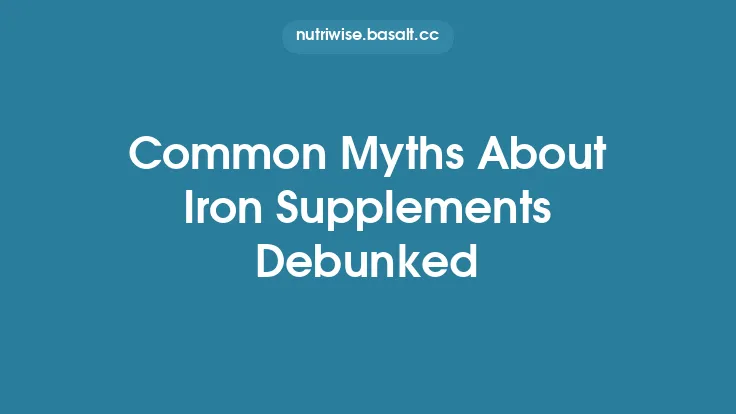Vitamin D is one of the most talked‑about micronutrients when it comes to skeletal health, and it’s easy to see why: headlines frequently tout its “miracle” benefits, while social media feeds are littered with quick fixes and bold claims. Yet, the reality is far more nuanced. Below, we dissect the most common myths surrounding vitamin D and bone health, grounding each discussion in current scientific understanding and highlighting what truly matters for maintaining a resilient skeleton over a lifetime.
Myth 1: “More Vitamin D Always Means Stronger Bones”
The claim
If a little vitamin D is good, then a lot must be better. Some sources suggest that mega‑doses (e.g., 5,000–10,000 IU/day) can dramatically boost bone density and prevent fractures.
The reality
Vitamin D follows a classic dose‑response curve: benefits increase with intake up to a physiological plateau, after which additional amounts confer no extra advantage and may even become harmful. Randomized controlled trials (RCTs) such as the VITAL study and the ViDA trial have shown that doses above the range needed to achieve serum 25‑hydroxyvitamin D (25(OH)D) concentrations of ~30 ng/mL do not further improve bone mineral density (BMD) or reduce fracture risk. In fact, meta‑analyses of high‑dose supplementation (>4,000 IU/day) reveal a modest uptick in hypercalcemia and renal stone formation, without measurable skeletal gains.
Key takeaway
Aim for sufficient—not excessive—vitamin D status. For most adults, achieving serum 25(OH)D levels between 30–50 ng/mL (75–125 nmol/L) is adequate for optimal calcium absorption and bone remodeling. Beyond that, the law of diminishing returns applies.
Myth 2: “Vitamin D Alone Can Prevent Fractures”
The claim
Because vitamin D is essential for calcium absorption, taking it by itself should be enough to keep bones fracture‑proof.
The reality
Bone strength is a product of both bone quantity (density) and bone quality (microarchitecture, turnover rate, mineralization). Vitamin D is a critical piece of the puzzle, but it works synergistically with other nutrients—most notably calcium, magnesium, vitamin K2, and protein. Large‑scale trials such as the Women’s Health Initiative (WHI) demonstrated that combined calcium (1,200 mg) and vitamin D (800 IU) supplementation modestly reduced hip fracture incidence, whereas vitamin D alone did not achieve a statistically significant effect.
Key takeaway
A holistic approach that includes adequate calcium intake, weight‑bearing exercise, and overall nutritional adequacy is required for meaningful fracture risk reduction. Vitamin D is a facilitator, not a standalone solution.
Myth 3: “Sunlight Exposure Is a Simple Solution”
The claim
A daily 10‑minute walk in the sun will automatically provide all the vitamin D you need for bone health.
The reality
Cutaneous synthesis of vitamin D depends on multiple variables: latitude, season, time of day, skin pigmentation, age, clothing, sunscreen use, and atmospheric conditions. For example, a fair‑skinned individual at 40° N latitude may produce ~1,000 IU after 15 minutes of midday sun in summer, whereas a darker‑skinned person in the same setting may generate only a fraction of that amount. Moreover, aging reduces the skin’s 7‑dehydrocholesterol content by ~50% after age 70, sharply diminishing synthesis capacity.
Key takeaway
Sunlight can contribute substantially to vitamin D status, but its effectiveness is highly individualized. Relying solely on sun exposure without accounting for personal and environmental factors can lead to suboptimal levels, especially in winter months or higher latitudes.
Myth 4: “Vitamin D Deficiency Is the Sole Cause of Osteoporosis”
The claim
If you have low vitamin D, you will inevitably develop osteoporosis.
The reality
Osteoporosis is a multifactorial disease. While severe vitamin D deficiency (<10 ng/mL) can impair calcium absorption and trigger secondary hyperparathyroidism—both detrimental to bone—most cases arise from a combination of genetic predisposition, hormonal changes (e.g., estrogen loss), chronic inflammation, sedentary lifestyle, and inadequate intake of other bone‑supporting nutrients. Epidemiological data show that many individuals with osteoporotic fractures have serum 25(OH)D levels within the “sufficient” range, underscoring that deficiency is a risk factor, not a deterministic cause.
Key takeaway
Address vitamin D status as part of a broader osteoporosis prevention strategy that includes hormonal health, physical activity, and comprehensive nutrition.
Myth 5: “All Vitamin D Supplements Are Equivalent”
The claim
A generic over‑the‑counter vitamin D pill works just as well as a prescription‑strength formulation.
The reality
Supplement efficacy hinges on several factors:
- Form – Vitamin D exists as D₂ (ergocalciferol) and D₃ (cholecalciferol). D₃ is more potent and has a longer half‑life, raising serum 25(OH)D more efficiently.
- Bioavailability – Oil‑based softgels improve absorption compared with dry tablets, especially in individuals with fat malabsorption disorders.
- Quality control – Not all products contain the label‑declared amount; some may be under‑ or overdosed due to manufacturing variability.
A 2022 systematic review found that D₃ supplements increased 25(OH)D concentrations by ~1.5 ng/mL per 100 IU, whereas D₂ achieved only ~0.8 ng/mL per 100 IU on average.
Key takeaway
Prefer vitamin D₃ in a lipid‑based delivery system, and choose reputable brands that undergo third‑party testing for potency and purity.
Myth 6: “Vitamin D Toxicity Is Improbable”
The claim
Because the body regulates vitamin D tightly, you can’t overdose on it.
The reality
Vitamin D toxicity (hypervitaminosis D) is rare but real, typically resulting from chronic ingestion of megadoses (>10,000 IU/day) over months. Excessive vitamin D drives hypercalcemia, which can manifest as nausea, polyuria, nephrolithiasis, and, in severe cases, vascular calcification. Case reports have documented toxicity from unregulated high‑dose supplements and from “megavitamin” regimens promoted online.
Key takeaway
Adhere to recommended upper intake levels (4,000 IU/day for most adults) unless supervised by a healthcare professional. Periodic monitoring of serum calcium and 25(OH)D is prudent for anyone on high‑dose regimens.
Myth 7: “Vitamin D Works Instantly”
The claim
Take a vitamin D supplement today and feel your bones get stronger tomorrow.
The reality
Bone remodeling is a slow, continuous process. After initiating supplementation, serum 25(OH)D typically rises within 4–8 weeks, but measurable changes in BMD require 6–12 months of sustained adequate status, coupled with mechanical loading (exercise). Moreover, the skeletal response is mediated by downstream hormones (parathyroid hormone, calcitonin) and cellular activity (osteoblasts/osteoclasts), which cannot be accelerated beyond physiological limits.
Key takeaway
Patience and consistency are essential. Expect gradual improvements in biochemical markers before observing structural bone changes.
Myth 8: “Vitamin D Is Only About Bone Health”
The claim
Vitamin D’s relevance ends at the skeleton; it has no other physiological roles.
The reality
While this article focuses on bone, vitamin D receptors (VDR) are expressed in virtually every tissue, influencing immune modulation, muscle function, and cardiovascular health. For bone health specifically, vitamin D also affects muscle strength, which indirectly reduces fall risk—a major contributor to fracture incidence. However, conflating these broader effects with bone‑specific outcomes can blur the evidence base. The consensus remains that vitamin D’s primary, well‑established role in skeletal health is facilitating calcium homeostasis.
Key takeaway
Recognize vitamin D’s systemic influence, but keep expectations realistic: its most robust, evidence‑based impact on the skeleton is through calcium metabolism and muscle performance.
Myth 9: “One‑Size‑Fits‑All Vitamin D Levels”
The claim
Everyone should target the same serum 25(OH)D concentration for optimal bone health.
The reality
Individual requirements vary based on age, body composition, genetic polymorphisms (e.g., CYP2R1, GC), comorbidities (chronic kidney disease, malabsorption), and medication use (glucocorticoids, anticonvulsants). For instance, older adults often need higher intakes to achieve the same serum level due to reduced skin synthesis and renal conversion efficiency. Conversely, individuals with sarcoidosis may develop hypercalcemia at modest 25(OH)D concentrations, necessitating lower targets.
Key takeaway
Personalize vitamin D goals. Routine testing can guide tailored supplementation, especially for high‑risk groups.
Myth 10: “Vitamin D Can Replace Calcium”
The claim
If you have enough vitamin D, you don’t need to worry about calcium intake.
The reality
Vitamin D enhances intestinal calcium absorption, but it cannot create calcium where none exists. In the absence of adequate dietary calcium (≈1,000 mg/day for adults), even optimal vitamin D status cannot prevent bone demineralization. Studies comparing high‑dose vitamin D with low calcium intake versus moderate calcium with adequate vitamin D consistently show inferior BMD outcomes in the former scenario.
Key takeaway
Maintain both sufficient calcium and vitamin D. Think of vitamin D as the “key” that unlocks calcium’s benefits, not a substitute for the mineral itself.
Putting It All Together: A Pragmatic Blueprint for Skeletal Wellness
- Assess Your Baseline – A single serum 25(OH)D measurement, ideally drawn in late winter, provides a realistic snapshot of status. Pair this with calcium intake assessment (dietary logs or food frequency questionnaires).
- Choose the Right Supplement – Opt for vitamin D₃, oil‑based formulations, and reputable brands. Start with a dose that safely raises serum levels to the 30–50 ng/mL window, adjusting based on follow‑up labs.
- Integrate Complementary Strategies –
- Calcium: Aim for 1,000–1,200 mg/day from dairy, fortified foods, or supplements.
- Weight‑Bearing Exercise: Activities like walking, resistance training, and dancing stimulate osteoblast activity.
- Vitamin K2 & Magnesium: These co‑factors support proper calcium deposition in bone rather than soft tissue.
- Monitor Periodically – Re‑measure 25(OH)D after 8–12 weeks of supplementation, and annually thereafter. Check serum calcium and renal function if using high doses.
- Stay Informed, Not Alarmed – Recognize that myths often arise from oversimplified interpretations of complex data. Rely on peer‑reviewed research and professional guidance rather than anecdotal claims.
Bottom Line
Vitamin D is undeniably vital for bone health, but its role is often exaggerated or misunderstood. By dispelling common myths—about dosage, solitary efficacy, sunlight, toxicity, and more—we can adopt a balanced, evidence‑based approach that maximizes skeletal strength while avoiding pitfalls. The cornerstone of bone resilience remains a combination of adequate micronutrients, regular mechanical loading, and individualized care. Armed with accurate knowledge, you can make informed decisions that support a robust, healthy skeleton throughout life.





